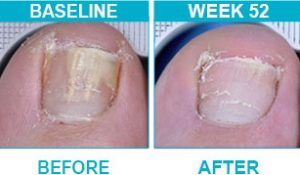If you’re suffering from yellow toenails, and you’ve been watching a lot of television lately, there’s one new solution that might have captured your attention.
A new topical prescription drug called Jublia (efinaconazole) has received FDA approval, and the company that sells it has since embarked on a heavy media campaign.

Jublia Topical Solution is a prescription medicine used to treat fungal infections of the toenails.
It is specifically formulated to reach the site of onychomycosis, the root cause of toenail fungus, and a condition that affects approximately 35 million people in the US alone.
Jublia is considerably easier to use than some of the DIY laser solutions on the market.
You simply squeeze a drop on to each toenail, or two for the big toenail. Then brush around the entire nail, including the cuticle folds of skin either side of the nail, and underneath it.
Does Jublia Work?
Well, the user experiences scattered around the Internet provides a mixed bag of reviews.
But here is what we know:
Jublia has undergone 2 clinical trials where users applied the solution daily on fungus infected toenails for 48 weeks.
Here are the result of each study:
Jublia Study 1
- 18% had completely clear nails — no fungus present after the treatment, and no visible toenail impairment.
- 26% has clear or mostly clear nails — no fungus present, and no more than 5% visible toenail impairment.
- 55% tested toenail fungus free.
Jublia Study 2
- 15% had completely clear nails — no fungus present after the treatment, and no visible toenail impairment.
- 23% has clear or mostly clear nails — no fungus present, and no more than 5% visible toenail impairment.
- 53% tested toenail fungus free.

Whilst there were no known drug interactions in the trials, there were several side effects reported in around 2% of the total patients tested.
These included: ingrown toenail, redness, itching, swelling, burning/stinging, blisters, and pain.
If we look at the overall cure rate, 18% and 15% respectively, that translates to somewhere between a 1/5 and 1/6 chance that Jublia will cure your toenail fungus without leaving any visible impairment of the toe (an ingrown nail, for example).
It’s a modest shot at a complete cure, but we must also consider the length of treatment and the cost of the prescription.
Some additional insights from the Jublia clinical trials:
Were there any differences in how well the drug worked in clinical trials among sex, race and age?
- Sex: A greater trend towards efficacy was observed in women than men taking Jublia.
- Race: A greater trend towards efficacy was observed in Asians than Whites or Black/African Americans taking Jublia.
- Age: Jublia is similarly effective among those above and below 65 years of age.*
*Jublia hasn’t been tested for under 18s.
You may wish to factor these observations in to your calculations of whether Jublia will work for you.
How Much Does Jublia Cost?
Well, it’s certainly not cheap.
Local chain pharmacies have been reported to charge between $530-$590 for a 4ml bottle.
A typical 4ml bottle will have 80 drops.
If you have just a single fungus infected toenail, this bottle would last you over 11 weeks.
Unfortunately, if you have ten infected toenails (including the big ones that require two drops each), we’re looking at 12 drops per day and each bottle lasting only a week.
The clinical trials were run over the course of 48 weeks.
One infected (non big) toenail
5 bottles required ($550 average)
Total cost: $2750
Chance of total cure: 15-18%
All toenails infected
48 bottles required ($550 average)
Total cost: $26,400
Chance of total cure: 15-18%
As you can see, a full 48 weeks of treatment with Jublia turns out to be rather expensive; and the price scales exponentially with the number of toenails infected with fungus.
If your insurance company is willing to foot the bill, then it could justifiably be worth trying.
Over half the people tested in the clinical trials were fungus-free at the end of their 48 weeks. If you perceive the trade-off of possible side effects to be worth getting fungus-free, then this makes Jublia look a much better bet.
We suspect, for many, your capacity to obtain the prescription on insurance will determine whether you should try Jublia, or opt for one of the untested (but much cheaper) home remedy kits on the market.

